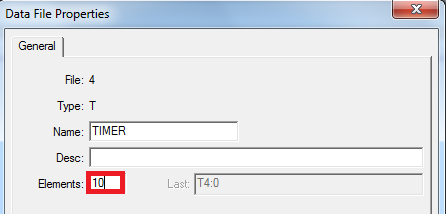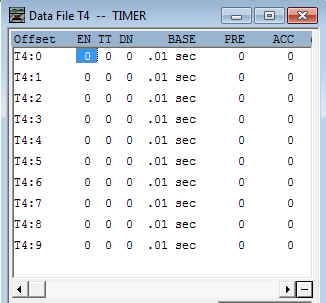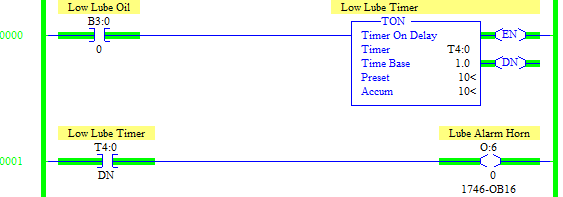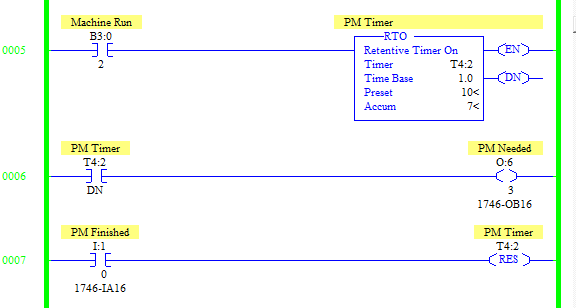Introduction to timers in the SLC-500 Processor.
Timers in the SLC-500 processor are very similar to timers in other AB Processors. There are 3 types of timers: On Delay (TON), Off Delay (TOF) and the Retentive Timer (RTO).
The On Delay Timer (TON) delays the Done bit (DN) from turning on. An Off Delay Timer (TOF) Delays the Done bit from shutting off. The Retentive Timer (RTO) retains the accumulated value.
By default, file T4 stores the timers. In the SLC-500, 256 timers can be created in the T4 Data file. If this is not enough timers, you can create other timer data files. However, be aware of your processor’s memory limitations!

By default, the T4 file only contains one timer, so I will add more. To do this, right-click the T4 file, and go to the properties. I will increase the size of the data file to 10 elements. You can only expand a data file offline in the SLC-500. It’s a good idea to create a few extra for later use if you need them while online. Be sure to press OK (not shown).

If you open the T4 data file, you will see there are 10 timers now that we can use in our project. Each of these timers has an Enable Bit (EN), Timer Timing Bit (TT), and a Done Bit (DN). The timers will also have a time base, and Accumulated Value (ACC), and a Preset (PRE). To determine the preset of a timer in seconds, multiply the preset value by the time base. You must be very careful not to get a negative value into the preset or accumulator. A processor fault will occur.

On Delay Timer (TON)
We use the On Delay Timer to delay the Done bit from turning on. A practical example would be a horn that blows for 5 seconds before equipment starts. Use the TT bit to blow the horn, and then the DN bit to start the equipment. The TON is also used in alarms. We don’t want the operator to get nuisance alarms, so we might wait wait a few seconds if we detect an alarm condition before notifying the operator.
Here is an example of the TON instruction. If the alarm condition persists for 10 seconds, the alarm horn will sound.

Timer Off Delay (TOF)
The off delay timer is probably the most widely confused timer. When we enable the timer, both the TT and the DN Bit go high. When we disable, the timer, the accumulator will start timing. The DN bit will shut off after the timer times out.
A practical use for the TOF would be to run off a conveyor. After the operator shuts down a conveyor system, the product will continue to move until the conveyor has time to clear. Another example is a blower on a motor. When a main motor starts, the blower starts instantly. When the motor shuts off, the blower will continue to run until enough time has passed for the motor to cool. It can also be used for post lube systems, and to blow a line clear of product before the DN bit shuts off.
Here is an example of the TOF instruction:

Once we shut off B3:0/1, the Main Motor shuts off, and the timer begins to run. Notice the Blower motor is still running, and will continue to run until that accumulator reaches 10. I do not recommend using a RES (Reset) instruction with this timer as it can cause unpredictable operation.
Retentive Timer (RTO)
The Retentive timer works in a similar way as the TON instruction…. with one exception. The RTO retains it’s accumulated value when the timer is disabled. We use the Reset (RES) instruction to set the accumulated value back to 0.
Examples of uses of the RTO include a machine hour meter. When used in conjunction with a counter instruction, the RTO, can keep total track of run time for maintenance reasons. When the timer hits 1 hour, it can trigger a counter and reset itself. The counter will then reflect the total run hours. Another use is for Preventative Maintenance (PM). After a certain run time has passed, a light will energize. We will use a reset button to reset this timer after the PM is finished.
Here is an example of using an RTO:

You will notice that the machine run bit is false. However, the RTO has retained it’s accumulated value. When the RTO times out, the DN bit will go true, and our PM light comes on. To reset the timer, press I:1/0.
To see other posts on the SLC-500, visit the Category Page!
— Ricky Bryce
